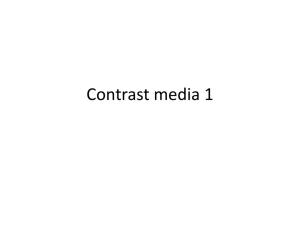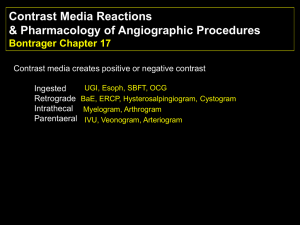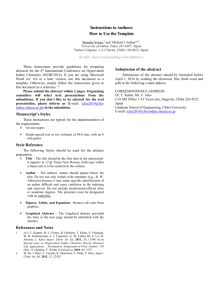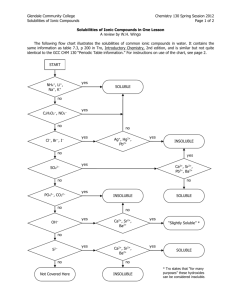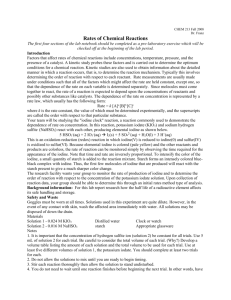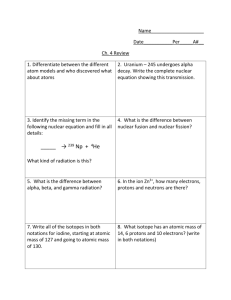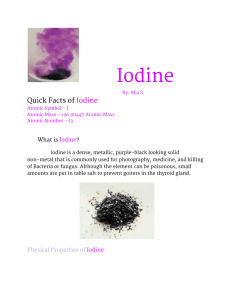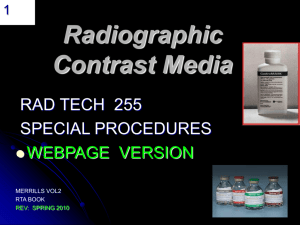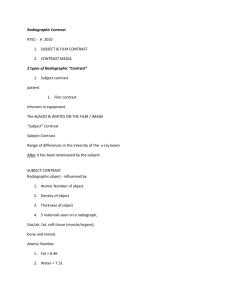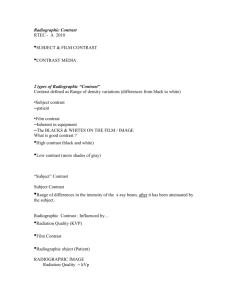CONTRAST MEDIA AND EXAMINATIONS
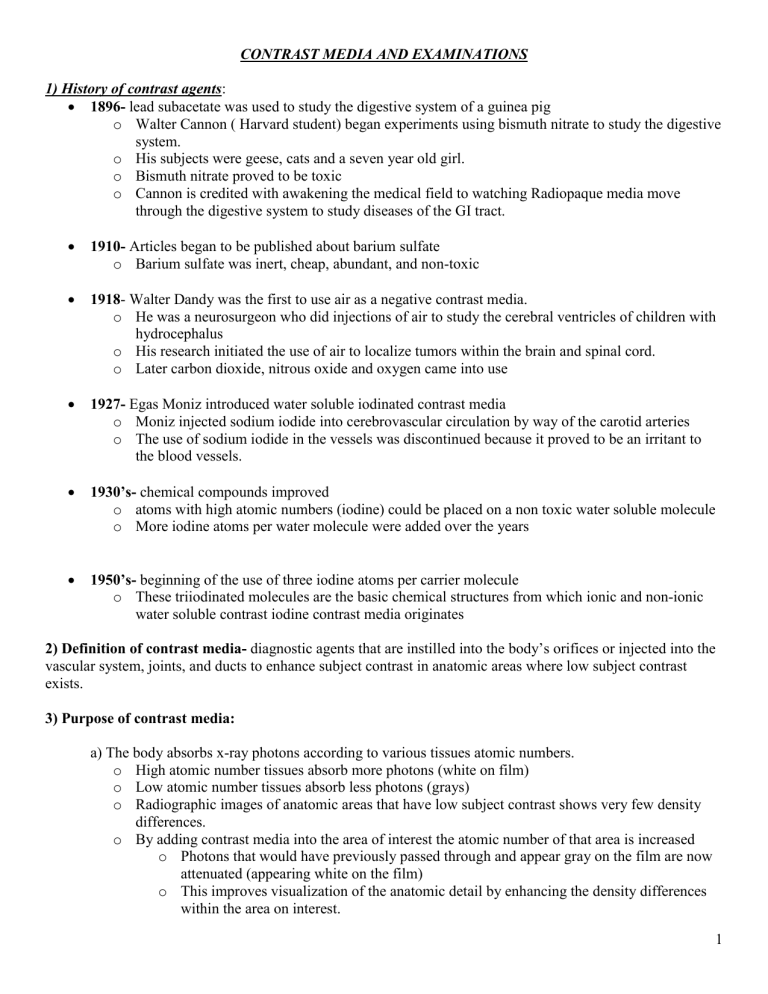
CONTRAST MEDIA AND EXAMINATIONS
1) History of contrast agents :
1896- lead subacetate was used to study the digestive system of a guinea pig o Walter Cannon ( Harvard student) began experiments using bismuth nitrate to study the digestive system.
o His subjects were geese, cats and a seven year old girl.
o Bismuth nitrate proved to be toxic o Cannon is credited with awakening the medical field to watching Radiopaque media move through the digestive system to study diseases of the GI tract.
1910- Articles began to be published about barium sulfate o Barium sulfate was inert, cheap, abundant, and non-toxic
1918 - Walter Dandy was the first to use air as a negative contrast media. o He was a neurosurgeon who did injections of air to study the cerebral ventricles of children with hydrocephalus o His research initiated the use of air to localize tumors within the brain and spinal cord. o Later carbon dioxide, nitrous oxide and oxygen came into use
1927- Egas Moniz introduced water soluble iodinated contrast media o Moniz injected sodium iodide into cerebrovascular circulation by way of the carotid arteries o The use of sodium iodide in the vessels was discontinued because it proved to be an irritant to the blood vessels.
1930’s- chemical compounds improved o atoms with high atomic numbers (iodine) could be placed on a non toxic water soluble molecule o More iodine atoms per water molecule were added over the years
1950’s- beginning of the use of three iodine atoms per carrier molecule o These triiodinated molecules are the basic chemical structures from which ionic and non-ionic water soluble contrast iodine contrast media originates
2) Definition of contrast media diagnostic agents that are instilled into the body’s orifices or injected into the vascular system, joints, and ducts to enhance subject contrast in anatomic areas where low subject contrast exists.
3) Purpose of contrast media: a) The body absorbs x-ray photons according to various tissues atomic numbers. o High atomic number tissues absorb more photons (white on film) o Low atomic number tissues absorb less photons (grays) o Radiographic images of anatomic areas that have low subject contrast shows very few density differences.
o By adding contrast media into the area of interest the atomic number of that area is increased o Photons that would have previously passed through and appear gray on the film are now attenuated (appearing white on the film) o This improves visualization of the anatomic detail by enhancing the density differences within the area on interest.
1
4) There are TWO classifications of contrast media: o Negative o Decrease attenuation of the x-ray beam and produces increased density on image o Positive o Increased attenuation of the x-ray beam and produces decreased density on the image
5) Negative Contrast Media: o Low atomic number elements o In the form of gas, air, gas producing crystals, soda water, carbon dioxide or oxygen o Adverse reactions o Can cause an emboli o Usually there are no complications when used alone
6) Positive Contrast Media a) Barium Sulfate b) Water Soluble Iodine c) Oil based Iodine o Barium Sulfate (atomic number 56) o Radiopaque o Inert powder composed of crystals o Used for examining digestive system o 1 atom of barium, 1 atom of sulfur, and 4 atoms of oxygen o Not soluble in water o Must be mixed or shaken into a suspension in water o Has a tendency to clump and come out of suspension (flocculation) o Stabilizers (sodium carbonate and sodium citrate) are used to prevent flocculation o To increase palatability vegetable gums, sweeteners and flavoring are added. o BA is mixed with cold tap water when doing Barium Enemas to prevent spasms, cramping and aid in the holding of the enema by the patient during the exam o If patient might have a perforation BA should not be used o The body cannot absorb BA naturally o If it leaks into the peritoneal or pelvic cavity it can cause peritonitis and must be removed surgically.
2
o Adverse Reactions to BA o BA within the colon can dry and cause an obstruction o Constipation o Extravasation from colon perforation o Certain patients :
Older patients
Pt using long term steroids
Pts with Diverticulitis
Pts with ulcerative colitis
Pt with megacolon o Vaginal rupture due to improper placement o Hypervolemia- water from colon can be shifted into the circulatory system with a resulting increase in blood volume o Sedated patients should not have an UGI die to risk of aspiration o Few allergic reactions, those who do have reactions are usually having an allergy to the preservatives o Water soluble Iodine contrast media
A) Non-ionic
B) Ionic o Ionic iodine contrast media (atomic number 53) o Dissociates into two molecular particles into water and blood plasma o They are ionic because 1 is positive (cation)and 1 is negative (anion) o Higher Osmolality o Has more reactions due to high Osmolality o
** Osmolality- is the measure of the total number of particles in solution per kg of water.** o Non-ionic iodine contrast media o Developed to prevent reactions from ionic media o Do not dissociate o Lower Osmolality o EX: Isovue and Visipaque o More water soluble than ionic o Less likely to have an allergic reaction
Heating to body temp decreases viscosity and facilitates rapid injection
3
o Allergic like effects from Iodine based contrast media (ANAPHYLACTOID) o Can be minor such as hives and itchiness o Can be more severe like bronchospasms, wheezing and edema in throat and lungs o Renal Effects from Iodine based contrast media o Increased BUN and Creatnine levels may indicate pt is more at risk for renal effects o Pts with renal disease, diabetes or older patients are more at risk for complications o Other effects of Iodine based contrast Media o Warmth or pain on injection o Extravasation o Pts taking medications such as adrenergic blockers, glucophage, calcium channel blockers are more at risk. o Oil based contrast Media o Made from fatty acids found in plants and animals o Insoluble in water o Do not flow easily because their viscosity o Common exams
Bronchography
Dacrycystography
Sialography
Lymphography o Adverse reactions o Anaphylactoid o Nausea and vomiting o Headache o Extravasation o Itchy skin and rashes
4
